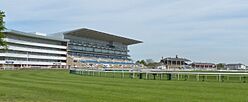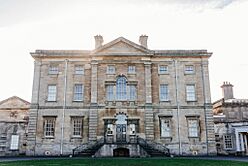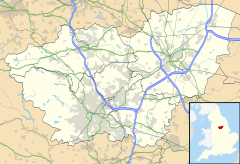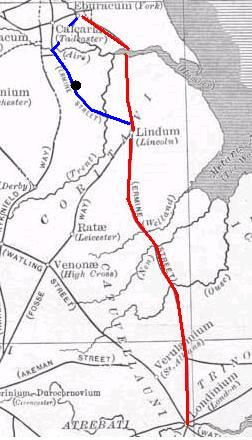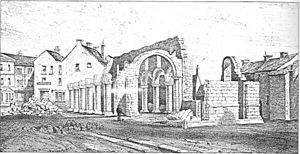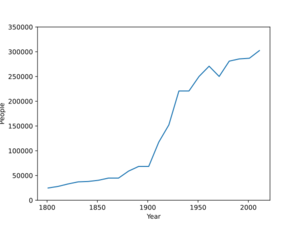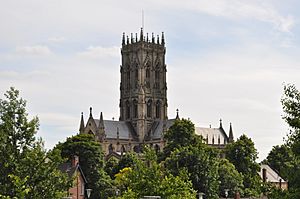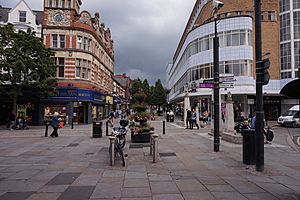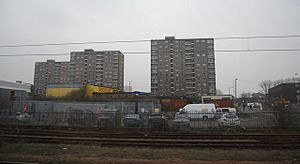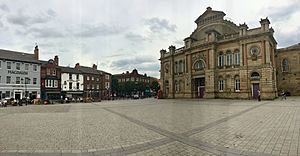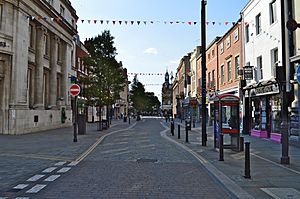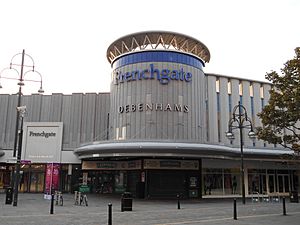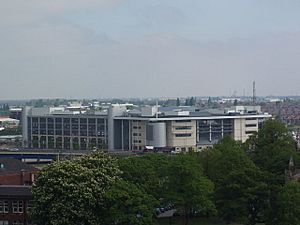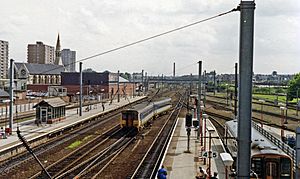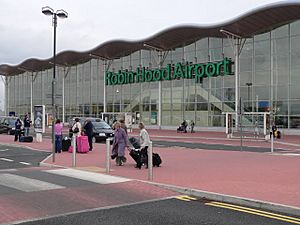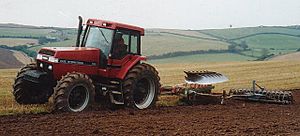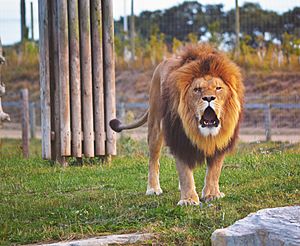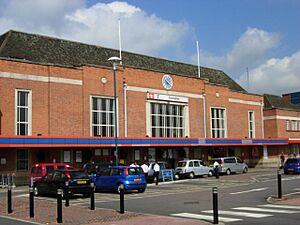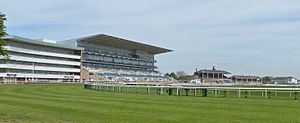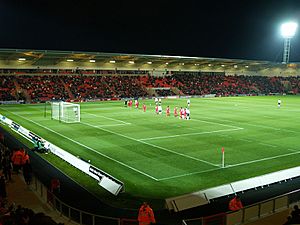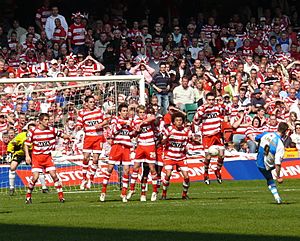Doncaster facts for kids
Quick facts for kids Doncaster |
|
|---|---|
| City | |
|
Top to bottom, left to right: Doncaster Racecourse, St George's Minster, Corn Exchange, Civic Office, Lakeside and Cusworth Hall |
|
| Area | 43.5 km2 (16.8 sq mi) |
| Population | 87,455 (Built up area, 2021) 308,100 (Borough, 2021) |
| OS grid reference | SE575032 |
| Metropolitan borough |
|
| Metropolitan county | |
| Region | |
| Country | England |
| Sovereign state | United Kingdom |
| Post town | DONCASTER |
| Postcode district | DN1-DN12 |
| Dialling code | 01302 |
| Police | South Yorkshire |
| Fire | South Yorkshire |
| Ambulance | Yorkshire |
| EU Parliament | Yorkshire and the Humber |
| UK Parliament |
|
Doncaster is a city in South Yorkshire, England. It's named after the River Don. Doncaster is the main centre of the City of Doncaster area. It is the second largest place in South Yorkshire after Sheffield. The city is famous for its horse racing and its history with railways. It sits in the Don Valley, near the Humberhead Levels and the Pennines mountains.
In 2021, Doncaster had a population of 87,455 people in its main built-up area. The wider area, called the metropolitan borough, had about 308,100 people. Nearby towns include Barnsley, Wakefield, Pontefract, Selby, Goole, Scunthorpe, Gainsborough, Retford, Worksop and Rotherham. Doncaster is well connected to these places by roads and railways.
Doncaster officially became a city in 2022. This happened as part of the Platinum Jubilee Civic Honours for Queen Elizabeth II. King Charles III and Queen Camilla visited Doncaster on 9 November 2022 for a special ceremony.
Contents
- Discovering Doncaster's Past: A Journey Through Time
- Doncaster's Landscape and Environment
- Doncaster's People and Economy
- Culture and Things to Do in Doncaster
- Getting Around Doncaster
- Media and News
- Sports in Doncaster
- Doncaster's International Friends
- Famous People from Doncaster
- Images for kids
- See also
Discovering Doncaster's Past: A Journey Through Time
Roman Times: Danum, a Key Fort
Doncaster started as a Roman fort around the 1st century CE. It was built where the River Don could be crossed. The Romans called this fort Danum. It was an important stop on the road between Lincoln and York. This road was an alternative to crossing the Humber by boat.
Archaeologists have found many interesting Roman sites in Doncaster. The Roman fort is believed to be where St George's Minster stands today. Roman records show that a special cavalry unit, the Crispinian Horse, was based here. In 1971, a Roman shield called the Danum shield was found at the fort site.
Medieval Doncaster: From Burh to Busy Town
Doncaster was an Anglo-Saxon settlement and got its name from the River Don and the Old English word "ceaster" (meaning fort). In the 11th century, after the Norman Conquest, a man named Nigel Fossard strengthened the town. He also built Conisbrough Castle nearby.
By the 13th century, Doncaster was a busy town. In 1194, King Richard I gave it a special town charter. A big fire in 1204 destroyed many wooden buildings, but the town slowly recovered.
In 1248, Doncaster was given permission to hold a market. This market is still running today! It's held in the 19th-century Doncaster Corn Exchange building. During the 14th century, many friars (religious people) came to Doncaster. The town also had hospitals, a school, and a stone bridge with a chapel. By 1334, Doncaster was the richest town in southern Yorkshire.
Many streets in Doncaster have names ending in "-gate," like Baxtergate or Frenchgate. "Gate" comes from an old Danish word meaning street. In medieval times, people with similar jobs often lived on the same street. For example, Baxtergate was where the bakers lived.
The medieval town was protected by walls and ditches. It had four main gates at Hall Gate, St Mary's Bridge, St Sepulchre Gate, and Sunny Bar. Today, large "Boar Gates" at Sunny Bar and "Roman Gates" at St Sepulchre Gate remember these old entrances.
Modern Growth: From Tolls to Trains
In the 17th century, Doncaster continued to grow. However, it faced several outbreaks of the plague between 1562 and 1606. During the First English Civil War, King Charles I visited Doncaster in 1645. Later, in 1664, King Charles II made Doncaster a "Free Borough" to thank the town for its loyalty.
Doncaster became connected to the railway network in 1848. A large factory for the Great Northern Railway was built in 1853. This factory helped Doncaster become a major railway town. From the 1850s, coal mining also grew in the areas around Doncaster.
In 1974, Doncaster became part of the new county of South Yorkshire. Historically, Doncaster was known for its wealthy landowners and grand homes like Cusworth Hall. This wealth is still seen in buildings like the beautiful 18th-century Mansion House.
One of the most impressive buildings is St George's Minster. It was built in the 19th century and became a minster in 2004. Doncaster has always been an important transport hub. It sits on the Great North Road, which was the main route between London and Edinburgh.
Doncaster's Landscape and Environment
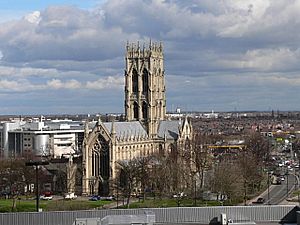
City Layout and Development
Doncaster is the second largest settlement in South Yorkshire. It is also the largest metropolitan district in England by land area. Its population grew a lot when coal mining developed. After the coal mines closed in the 1970s and 1980s, Doncaster focused on service industries. This was helped by its good transport links.
The city's skyline features the minster and the Frenchgate Shopping Centre. The new Doncaster Civic Office, which is the council building, was finished in 2012.
Natural Surroundings
Doncaster is in a low-lying valley in southern Yorkshire. To the west are hills leading to the Pennines. To the east are the flat Isle of Axholme and Humberhead Levels. The River Don's floodplains are to the north-east. This area sometimes floods, as seen in 2007 and 2019.
Protecting Nature
Doncaster has important nature areas:
- Thorne and Hatfield Moors: This is the largest area of low-lying peat bog in the UK. It's a national nature reserve.
- Potteric Carr: This area to the south includes the Potteric Carr Nature Reserve.
Doncaster also has a "green belt" around it. This is a special area of countryside that is protected from too much building. It helps stop cities from spreading too much and keeps green spaces for people to enjoy. Places like Hexthorpe Park and Cusworth Hall country park are part of this green belt.
Weather in Doncaster
Doncaster has a mild climate, like most of the UK. It doesn't get extreme temperatures. Because it's in the Don Valley and protected by the Pennines, it's one of the drier parts of the UK.
- The warmest day of the year usually reaches about 29.1°C (84.4°F).
- The lowest temperature ever recorded was -13.5°C (7.7°F) in December 1981.
- It rains on about 107 days a year. The total rainfall is quite low, around 560 mm (22 inches) annually.
Doncaster's People and Economy
Population Facts
In 2011, the main built-up area of Doncaster had 109,805 people. The wider Metropolitan Borough of Doncaster had a population of 302,402. By 2021, this was estimated to be 308,000.
How Doncaster Makes Money
Doncaster became an important industrial centre from the late 1700s to the 1900s. Its waterways helped transport goods, and many people moved there for work. There's a lot of coal deep under Doncaster, which was a big part of its history.
Logistics and Warehousing
Doncaster is great for distribution because it's close to major cities and motorways. It has large centres like the Doncaster International Railport, which sends goods to Europe. Many big companies like Next, Tesco, IKEA, and Amazon.com have large warehouses here.
City Improvements
Doncaster is a "Fairtrade Town", meaning it supports fair trade. The Doncaster Lakeside area has been updated, with the Doncaster Rovers football ground. There's also a bowling alley, a cinema, and The Dome, which has a swimming pool, gym, and ice rink.
The Frenchgate Centre is a big shopping centre that connects to the railway and bus stations. Lakeside Village is another shopping area with many shops and restaurants. The Waterdale area in the city centre has also been improved with a new theatre called CAST and new council offices.
Sweet Treats and Industry
In the past, Doncaster was known for sweets like Parkinson's Butterscotch and Nuttalls Mintoes.
The River Don and its canals were used to transport coal from Doncaster to steel factories in Rotherham and Sheffield. While coal mining has stopped, Doncaster still has industries like Rockware Glass, which makes glass. Bridon Ropes makes wire ropes, including those used in coal mines. It's one of the biggest wire rope factories in Europe.
The Story of Railways
During the Industrial Revolution, the Great Northern Railway built a large factory in Doncaster to make locomotives and carriages. This factory was very important for transporting coal. The factory also built homes and a church for its workers.
The Doncaster factory became famous for building iconic locomotives like the Flying Scotsman and Mallard. Today, what remains of the factory is owned by Wabtec, which repairs and updates rail vehicles.
Doncaster railway station is a major stop on the East Coast Main Line. You can travel directly to many towns and cities across the UK from here. Doncaster also has one of the largest railway signalling centres in the UK. The National College for Advanced Transport and Infrastructure has a campus here, teaching about railways and transport.
Aviation History
In 1909, Doncaster Racecourse hosted an airshow, one of the first in the world. During the First World War, fighter planes were based near Doncaster to protect the east coast from airships. Later, during the Second World War, 271 (Transport) Squadron was based here. This squadron played a part in important operations like Operation Overlord (D-Day) and the Battle of Arnhem.
After the wars, the airfield was used for civilian flights. It closed in 1992. Doncaster Sheffield Airport opened in 2005 but closed in 2022.
Tractor Manufacturing
From 1930, International Harvester (IH) started making farm equipment and tractors in Doncaster. The first tractor was built in 1949. The factory grew and made tractors specifically for British and European markets. In 1985, the company became Case IH, and they continued making tractors in Doncaster. The 350,000th tractor was made in 1999.
In 2000, an Italian company bought the factory. However, in 2006, they announced the factory would close in 2007. This ended 61 years of tractor production in Doncaster.
Culture and Things to Do in Doncaster
The Doncaster Museum and Art Gallery opened in 1964. It has exhibits on natural history, archaeology, local history, and art. It also displays silverware and trophies from Doncaster Racecourse.
Doncaster is home to Yorkshire Wildlife Park. This park has over 400 animals from more than 70 different species. It's famous for being the only place in England where you can see polar bears!
The South Yorkshire Aircraft Museum is located at the old RAF Doncaster site. The Trolleybus Museum nearby has the largest collection of trolleybuses in Europe. Markham Grange Steam Museum has a private collection of steam engines. The Ashworth Barracks Museum tells military stories, including about soldiers who won the Victoria Cross.
Doncaster is also home to the Doncaster Youth Jazz Association (DYJA), which has trained many jazz musicians since 1973.
- In 1956, a goldfish named Tish was won at a funfair in Doncaster. Tish lived to be 43 years old, becoming the world's oldest known goldfish!
Theatre and Cinemas
- Cast is a modern theatre that opened in 2013. It has a 620-seat auditorium and other spaces for drama and dance.
- The Doncaster Little Theatre is a smaller community theatre with 99 seats. It puts on its own shows, including a pantomime.
- The town has an 11-screen Vue multiplex cinema.
- A new six-screen Savoy Cinema opened in 2021.
- You can also find events and concerts at Doncaster Racecourse and The Dome Leisure Centre.
Nightlife and Dining
Doncaster city centre has many bars and clubs, especially around Silver Street, Cleveland Street, and High Street. There are also many restaurants serving food from all over the world.
Getting Around Doncaster
Train Travel
Doncaster railway station is a very important station on the East Coast Main Line. It has nine platforms and connects Doncaster to many cities across the UK.
Several train companies operate services from Doncaster:
- CrossCountry trains go to places like Reading and Newcastle.
- East Midlands Railway runs trains to Lincoln and Peterborough.
- Grand Central connects Doncaster to Bradford Interchange and London King's Cross.
- Hull Trains offers services to Hull and London King's Cross.
- London North Eastern Railway has inter-city trains to London King's Cross, Leeds, York, Newcastle, Edinburgh and Glasgow.
- Northern operates local services to Sheffield, Leeds and Hull.
- TransPennine Express runs a route between Liverpool, Manchester Piccadilly and Cleethorpes.
Road Connections
Doncaster is located on major motorways like the A1(M) and M18. It's also close to the important M1 and M62 motorways. This makes it easy to travel to and from Doncaster by car.
Bus Services
Bus services in Doncaster are mainly run by First South Yorkshire and Stagecoach East Midlands. They connect the city to nearby towns like Barnsley, Gainsborough, and Worksop. Long-distance coaches also travel to major cities like London and Birmingham.
The Frenchgate Interchange is a modern building that combines the bus and railway stations with the Frenchgate Centre shopping mall.
Cycling Around Town
Cycling is becoming more popular in Doncaster. The city is on the Trans Pennine Trail, a route for cyclists and walkers. There are also more cycle lanes being built to make cycling safer for commuters.
Media and News
Television and Radio
Doncaster receives TV news from BBC Yorkshire and ITV Yorkshire, both based in Leeds.
For radio, Trax FM was a popular local station for many years. It was rebranded as Greatest Hits Radio South Yorkshire in 2020. TX1 Radio is a new digital radio station for Doncaster. Other stations like BBC Radio Sheffield and Hits Radio South Yorkshire also broadcast to the city. Sine FM and TMCR 95.3 are community radio stations.
Newspapers
The Doncaster Free Press is a weekly newspaper for the Doncaster area. Doncaster also has its own edition of the Sheffield Star newspaper. The Yorkshire Post is a daily newspaper from Leeds.
Sports in Doncaster
Horse Racing
Doncaster has a long history with horse racing, dating back to the 16th century. The Doncaster Gold Cup, first run in 1766, is the oldest continuing regulated horse race in the world. Doncaster Racecourse is a famous venue for races.
Rugby Football
- The Doncaster rugby league team was founded in 1951. They play at the Eco-Power Stadium.
- The Doncaster Knights rugby union team plays at Castle Park.
Football
- Doncaster Rovers is the city's professional football club. They play at the Eco-Power Stadium.
- Doncaster is also home to the successful women's football club, Doncaster Rovers Belles. They have a long history of providing players for the England national team. In 2021, England's women's team played a record-breaking match against Latvia in Doncaster.
Other Sports
- Speedway racing used to take place at Doncaster Greyhound Stadium in 1969 and 1970.
- Doncaster has a men's basketball team called the Doncaster Danum Eagles.
- The city also has an American football team, the Doncaster Mustangs.
- Doncaster has hosted stages of the Tour de Yorkshire cycling event in 2016 and 2018.
Doncaster's International Friends
Doncaster is twinned with several towns and cities around the world. This means they have special friendly relationships.
- Avion, France
- Herten, Germany
- Camden, England
- Gliwice, Poland
- Wilmington, United States
Some roads in the Lakeside area are named after these twin towns, like Gliwice Way and Herten Way. Doncaster used to be twinned with Ozyorsk, Russia, but this stopped after the 2022 conflict in Ukraine.
Famous People from Doncaster
Many talented people come from Doncaster:
- Emma Chambers, actress (from The Vicar of Dibley)
- Roy Clarke, writer (Last of the Summer Wine)
- Jeremy Clarkson, TV presenter (Top Gear)
- David Firth, animator
- Tan France, TV host (Queer Eye)
- Thomas Howes, actor (Downton Abbey)
- Kevin Keegan, famous football player and manager
- John McLaughlin, highly respected guitarist
- Danny Schofield, football coach and former player
- Sarah Stevenson, Taekwondo world champion
- Louis Tomlinson, singer (from One Direction)
- James Toseland, former motorcyclist and singer
- Diana Rigg, actress
- Danny Rose, former English football player
- Andrew White, TV presenter and writer
- Yungblud, singer and musician
Images for kids
See also
 In Spanish: Doncaster para niños
In Spanish: Doncaster para niños


